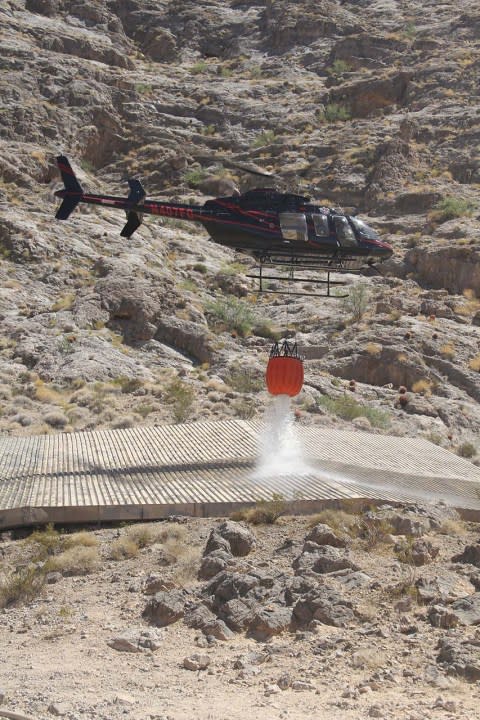Desert bighorns recovering after severe drought years on refuge near Las Vegas

LAS VEGAS (KLAS) — After a few brutal years of drought, 2023 brought some valuable recovery time for desert bighorn sheep at the Desert National Wildlife Refuge north of Las Vegas.
The estimated bighorn population rebounded by 12.7%, growing from 470 to 530 according to aerial surveys conducted in September. The surveys are done each year by the Nevada Department of Wildlife (NDOW) and the U.S. Air Force, which controls a large portion of the refuge that falls in the Nevada Test and Training Range.
“They are a symbol of resilience,” NDOW biologist Erin Wood said on Friday. “Bighorn sheep have existed in Nevada for millenia. When people expanded westward, our populations had a major effect on their populations.”

The Desert National Wildlife Refuge was set up in 1936 to protect habitat, but drought and the spread of bacterial pneumonia in recent years have taken a toll on Nevada’s official state animal.
Wood said that although Nevada has more desert bighorns than almost every other state, the population is recovering. She noted that the refuge and Valley of Fire State Park are great places to see the bighorns.
NDOW biologist Joe Bennett said bighorn populations in the refuge peaked in the mid-1980s. They were concentrated in the Sheep Range — one of five mountain ranges monitored by wildlife officials. Aerial surveys in 2021 showed a serious contraction in that herd, likely related to the drought’s impact on food and water sources.
Numbers in 2021 had dropped to half the levels reported in 2012 and 2017.
2022 report: Desert bighorn sheep numbers plunge on Nevada refuge
But a lot of the information about bighorns at the refuge isn’t easy to get. They usually stay deep in the rugged mountains. Average life span is 6-8 years, according to information posted by NDOW. When biologists have been able to get a collar on a bighorn, it showed they generally stay in their home mountain range when the drought isn’t too severe, according to Bennett. But they have been known to roam 200 miles from home, too.
There aren’t a lot of bighorns in the refuge that have been collared, Bennett said.
Add to that: U.S. Air Force restrictions that affect activity at the Desert Range, the Pintwater Range and the Spotted Range. “The short story is we don’t have a great grasp of it because it’s a very remote area to monitor and very difficult to access,” Wood said. An Air Force contractor handles the aerial counts in those ranges.

For some years, partial counts mean data is estimated on some parts of the refuge.
Wood said the wet weather in 2023 has improved conditions on the ranges she has been able to see. Biologists look at the number of bighorns, as well as the ages and distribution of the herd. She said there were more lambs in the most recent count. “That’s a good sign of potential growth and recovery.”

And observations of adult ewes and rams showed improvements: “Nobody too skinny or lethargic,” Wood said.
The habitat is greener, too.
But those are temporary changes. “It’s hard to say what the long term is going to be,” Wood said.
During the worst periods of drought, NDOW was busy recharging “guzzlers” — the remote water tanks that provide important support for bighorns through the drought. Most of the 40 water sources for bighorns on the refuge are guzzlers. They have to be restocked by hauling water by helicopter, and that’s not always possible given the schedules for military operations on the training range.
Predators aren’t a big threat to adult bighorns, who take advantage of their “escape terrain” and acute eyesight, Woods said. But lambs can fall prey to mountain lions, coyotes and even eagles.
It typically takes 2 to 3 years for females to mature for mating, and even longer for males. A ram doesn’t usually mate until it is 4-5 years old, but not every male ascends the hierarchy in the herd to mate with the ewes.
The sprawling 1.6 million acre range — the largest U.S. wildlife refuge outside of Alaska — protects the largest intact habitat for desert bighorns in the Mojave Desert.
For the latest news, weather, sports, and streaming video, head to KLAS.

